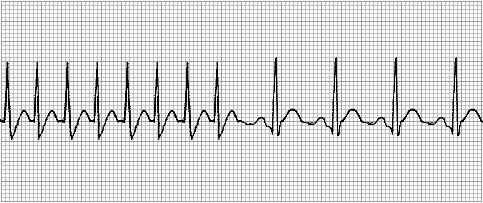|
An 80-year-old woman has been bothered for the past 3 months by what she describes as a "fluttering" of her heart that happens about once per week, lasting for about 10 minutes. The episodes seem to go away if she drinks a glass of blackberry brandy. She has had no medical problems in the past. On physical examination there are no remarkable findings.
Laboratory findings show: hematocrit 43%, glucose 87 mg/dL, total cholesterol 182 mg/dL, creatinine 0.7 mg/dL, and troponin I <1 ng/mL.
An EKG shows the following:

Questions:
4.1 What is the most likely diagnosis?
Paroxysmal supraventricular tachycardia (PSVT), previously known as paroxysmal atrial tachycardia (PAT), is characterized by episodes in which rapid, regular heart beats, up to 150 to 250/min, originate in the atrium. These episodes begin and end abruptly. Functional differences in conduction and refractoriness in the AV node or the presence of an AV bypass tract provide the substrate for the development of PSVT. Reentry may be localized to the sinus node, atrium, or AV node. A macro-reentrant circuit involving conduction in the antegrade direction through the AV node and retrograde through an AV bypass tract may also conduct in an antegrade fashion known as the Wolff-Parkinson-White (WPW) syndrome. Conditions that can induce PVST include excessive alcohol intake, stress, caffeine, and hyperthyroidism.
Compare with the following EKG:

The above EKG demonstrates atrial fibrillation.
Hypotension and syncope may occur because of the sudden loss of the atrial contribution to ventricular filling; this can also lead to a marked increase in atrial pressure, acute pulmonary edema, and a reduction in ventricular filling. Simultaneous atrial and ventricular contraction produces cannon a waves with each heartbeat.
4.2 What is the cardiac abnormality?
There is no specific myocardial or valvular disease.
4.3 What pharmacologic therapy is indicated?
In patients without hypotension, vagal maneuvers such as carotid sinus massage can terminate the arrhythmia in 80% of cases. If hypotension is present, raising the blood pressure by the cautious use of intravenous phenylephrine in 0.1-mg increments may terminate the arrhythmia alone or in combination with carotid sinus pressure. If these maneuvers are unsuccessful, verapamil (2.5 to 10 mg intravenously) or adenosine (6 to 12 mg intravenously) is the agent of choice. Adenosine is preferred because of its extremely short half-life, lessening the consequences of any side effects. Beta blockers may also be used to slow or terminate the tachycardia but are agents of second choice. Digitalis glycosides have a slower onset of action and should not be used for acute therapy. When these drugs fail to terminate the tachycardia, or when the tachycardia is recurrent, atrial or ventricular pacing via a temporary pacemaker inserted pervenously may be used to terminate the arrhythmia. However, if severe ischemia and/or hypotension is caused by the tachycardia, dc cardioversion should be considered.
AV nodal reentry can usually be prevented by the use of drugs that act primarily on the antegrade slow pathway (such as digitalis, beta blockers, or calcium channel antagonists) or on the fast pathway. Drugs most likely to avert recurrences prevent induction of the arrhythmias by programmed stimulation. This technique utilizes temporary pacemaker catheters connected to a physiologic stimulator capable of variable rate pacing and stimulation with one or more precisely timed premature impulses. In symptomatic patients who require chronic therapy, radiofrequency catheter modification of the AV node should be considered. This technique can cure AV nodal reentry in >90% of cases and has been proven to be safe, although a 1 to 2% risk of AV block requiring a permanent pacemaker exists.
4.4 What is the effect of the blackberry brandy?
Placebo. The amount is not an "excess" to have caused or prolonged the PVST.
4.5 What is the internal pacemaker of the heart and what is its natural rate? What is the effect of sympathetic or parasympathetic stimulation?
The sinoatrial (SA) node has an intrinsic rate of 70 to 80 beats/minute. The atrioventricular (AV) node has a rate of 40 to 60 beats/minute. The bundle of His in the ventricles has a rate of 40 beats/minute.
Sympathetic stimulation will act on beta-1 receptors to increase heart rate, increase contractility, and increase AV nodal conduction velocity. Parasympathetic stimulation on M2 receptors will have the opposite effect.
| 


